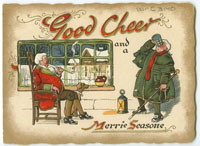December 9, 2011, by Fraser
9 December: Christmas cards
 This Christmas card from 1909 shows a traditional Christmas scene with a snow-covered roof and the bare branches of winter trees. True to the associations of the season, the use of a window on the card gives the idea of it being cold outside but toasty warm within. The card also illustrates indulgence with a portly man knocking back a festive tipple.
This Christmas card from 1909 shows a traditional Christmas scene with a snow-covered roof and the bare branches of winter trees. True to the associations of the season, the use of a window on the card gives the idea of it being cold outside but toasty warm within. The card also illustrates indulgence with a portly man knocking back a festive tipple.
Take a look at the best of the rest from Manuscripts and Special Collections and see how your cards for this year compare:
If you can’t see the gallery above, please visit our Flickr site.
We asked Keeper of Manuscripts and Special Collections, Dorothy Johnston, to tell us more about the tradition of exchanging Christmas cards:
‘The arrival of the first Christmas card begins the festive season in many homes, while the dismantling of displays of cards brings the holiday to an end. But in fact the Christmas card is not an ancient tradition. The first commercial cards appeared in the 1840s and their mass popularity dates from the late 19th and 20th centuries. Today, the e-card and new digital channels have provided other options. Current global concerns, such as carbon footprints, vie with charitable appeals as individuals choose their personal forms of communication.
Examples of early Christmas cards are found in both private papers and the archives of organisations. They hint at networks of friends and contacts – though other evidence may be needed to identify “Aunt Jane” or “Uncle Billy”. For the social and cultural historian, the pictures provide a surprising range of interest. The very first cards, like many today, focused on family enjoyment of a happy Christmas and good wishes for the approaching year. But other themes were constants over the years – including nativity scenes, flowers and landscapes, and animals, birds and pets.
Nostalgia for the “good old days” took many forms, from images of people making merry to peaceful village scenes. Small details – such as snow and sprigs of holly – provided shorthand references to the season, and images such as sun-dials were used to symbolize the passage of time.
The corporate card, produced by an official body or business, was a surprisingly early development. Among the University’s collections a few 1880s examples that survive from the city of Nottingham’s Post Office have a special local charm.
There are many 19th and 20th century archives of private individuals among the University’s historic collections. Greeting cards often survive in these papers, and add vividly to our view of how people a century ago kept in touch with friends and family at Christmas.’
All of the items featured in our e-Advent calendar are from the University’s historic library holdings, held in Manuscripts and Special Collections. For more information on the wide range of materials available, take a look at their website and blog or contact the curators on mss-library@nottingham.ac.uk.
![]()
Find out more about our Manuscripts development plans and how you can support us via the Impact Campaign website.
No comments yet, fill out a comment to be the first

Leave a Reply